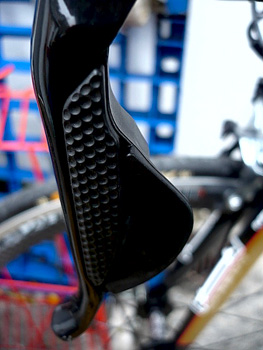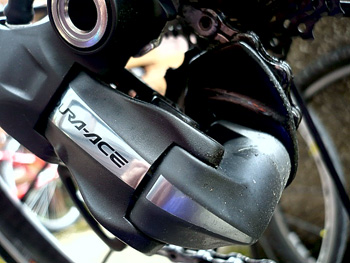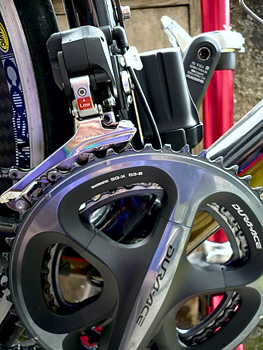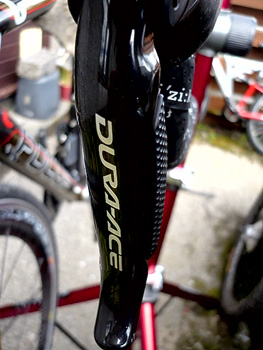
..........................................................................................................................................................................................................
shimano di2 electronic

it is perhaps ironic that, less than a year after campagnolo pointedly marketed campag red shifters, shimano should bring their electronic groupset to market. the red shifters were, according to vicenza, the result of their sponsored riders requesting levers with a stronger spring, giving them a stiffer, but apparently more positive gear shift. of course, it could all have been marketing, because campagnolo themselves moved to eleven speed and the red lettering disappeared from the ergo shifters on the professionals' bikes. ironic? well shimano have removed all trace of any effort required at all, to move front or rear derailleur up and down the sprockets or rings. and with a price considerably in excess of £2000, it is likely that only the professionals (and probably the well-heeled), that will ever come to appreciate this.
it does seem highly unlikely that shimano sponsored professionals are any different to those using italian componentry, so somewhare along the line i detect the intervention of a marketing ddepartment: shimano's response as to the necessity of electronics and thus a reduction in gear changing effort was to point out that several stage races and most certainly milan - san remo, reach distances that can tire even the fittest rider, and at times like these they may be less than pin sharp in their changing of ratios. i would dearly like to hear eddy merckx's reaction to that.
so what does shimano's dura-ace di2 accomplish that fly-by-wire systems do not? well, to be quite blunt, nothing at all. don't get me wrong, the system works beautifully; so beautifully, in fact that i have a crick in my neck from peering down at the cassette just to make sure that a change had been completed, so sure-footed and silent was the system. unlike the regular sti units, the carbon bladed brake lever has no lateral movement at all; upward shifts at the rear are accomplished by pressing a dimpled button on the side of the brake lever, while shifts to a smaller sprocket require gentle pressure on a bit of carbon (or plastic) pretending to be the little flip lever that appears on standard dura-ace. this latter switch has a small amount of give built in, or at least, pretends to have. in reality it only moves a short distance in making contact with the switch itself. there's not much in the way of feedback from either lever, and wearing long finger gloves doesn't do much for digital accuracy.

the front changing is very impressive, coming as it does with a fabulous electronic noise as the chain moves swiftly and accurately from inner ring to outer. this bit was so cool, i was inclined to shift up and down a few times for no particular reason.
the whole kit and caboodle is powered by a small(ish) battery which sits in a handy wee cradle held in place by the bottle cage bolts. the bike on which this system was tested was a focus izalco extreme (of which more later this week) and had the battery hooked off the seat-tube bolts; it's worth noting that the bolts are still able to affix a bottle cage while employed as a battery holder. i have, however, seen one or two other bicycles fitted with di2, that place the battery on the down tube. it doesn't really seem to make a lot of difference, though the focus solution seems less ugly. there is a small switch fitted inline with the cables as they exit the bars that places the gear system in adjust mode and indicates battery level, however, try as a might, i could never get this to tell me how much juice was left.
battery usage is excellent, at least it is with a new battery. i rode well over 450km before running scared and plugging the battery into its domestic charger; it took less than ten minutes to reach full-charge, so i guess it would run for a lot longer before a cold sweat took over. according to the accompanying manual, when the battery runs low, the front changer stops working first, followed soon after by the rear. it will apparently remain in whichever gear it was in when the power ran out, hearking back to last year's tour when one of the hapless gerolsteiner riders got stuck in the big ring and eleven sprocket when the battery died during a stage. unfortunately, we are unlikely to be followed by a car bearing a slew of replacement bicycles on the roof.

i had, perhaps naively, expected that all would be set to perfection on rolling the bicycle out of its very large box, and therefore simply climbed aboard and set off into the hinterlands. sadly this turned out not to be the case, with the chain sitting just at the point of wanting to find a new home on an adjacent sprocket. indexing has never made this a quiet affair. so, bereft of a barrel adjuster on the svelte rear mech, how does the boy racer go about lining everything up properly? that small switch incorporated into the wires at the front of the bike is the key to everything: put the chain into sprocket number five, press the tiny button until a small red led illuminates, then press either button on the brake lever to achieve minute calibration. in practice, this was remarkably easy; i managed while standing at the side of the road, rather than having to place the bike on the workstand. despite having swapped wheels about on the focus, i've never needed to adjust it again.
my first couple of rides were in customary islay rain, yet despite the battery sitting in a position where any precipitation was likey to drip into the contact area, it never missed a change, front or back. mavic are likely yellow with envy. i believe some team bikes are being delivered with appropriate holes in the frame to allow internal routing. the focus had no such provision, but the gear wiring was very stealth like and unobtrusive. the only rather incongruous feature was somewhat ugly and empty looking cable stops on each side at the top of the down tube. to be fair to focus, this particular frame is also available (at the same price) with campagnolo super record which will obviously need those cable stops.

perhaps the only mystifying point about such an electronic system is why they have remained faithful to the old positioning of gear change points; there is obviously a need for those to remain, but would it not have been easy, simple and forward thinking to have placed anothe couple of switches under the top of the bars, so that changing could be accomplished when in the characteristic robert millar climbing posture?
di2 works very well indeed, but then so does standard dura-ace at a far lower price, and with little or no chance of needing to be re-charged. if you're of a nervous disposition, i'd nip off and make an espresso while i relate the numbers: brake/gear levers £500; rear mech £490; front mech £370; front cables £85; rear cables £140; battery £ 60; charger £56. total price £2400.
nicely done, but to my mind, it's a solution looking for a problem.

posted on monday 8 june 2009
..........................................................................................................................................................................................................